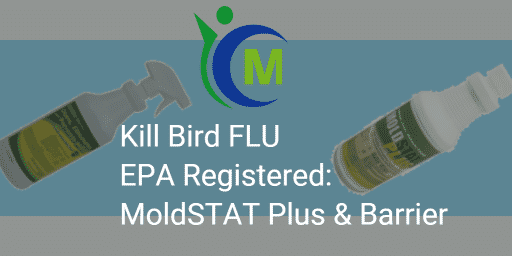Here at CleanerToday.com we have a committed focus on customer service and assistance. We dedicate many hours each day to helping customers understand how best to use our products and how to select which products will best fit their needs. Occasionally we will post these questions, and our answers to them, to help assist others who may be confronted with these relatively common situations.
We received the following inquiry from Deanna, a technology contractor, via email:
“During a recent move we found it necessary to store some clothing and other household items in a storage locker. When we opened the locker we found mold and mildew on a number of items. Can MoldStat and MoldStat Barrier be used on wicker baskets, ladies shoes, purses, luggage, cloth bags, leather shoes, leather purses, suede leather boots, tennis shoes?”
It may surprise some readers, but the situation Deanna finds herself in is not an uncommon one. Here at CleanerToday.com we hear from customers dealing with mold growth on items following storage, for even short periods, in rented storage lockers, especially those facilities which do not feature climate control, meaning that ambient moisture in the air can contribute to the growth of mold and mildew.
For the sake of clarity, the organisms that some people refer to as “mildew” are almost always one of two types of mold.
The answer to Deanna’s question is, unfortunately, maybe. Ultimately, the guiding principle when deciding whether or not to use MoldStat Plus, or MoldStat Barrier, is to determine the water washability of any given item.
MoldStat Plus is sold as a concentrate that the customer must dilute with water to create the solution strength to clean items. The bulk of any such solution will be water so the item to be cleaned must be able to withstand contact with water. It isn’t necessary to soak items in a MoldStat solution to clean the mold, so you could use just a light wiping with a heavily wrung out cloth or sponge to clean many items.
Many leather items, such as those Deanna mentioned, could likely be cleaned in this manner with no damage occurring.
Suede can almost never be cleaned with water. For suede items on which mold or mildew has grown, we would suggest consulting a dry cleaner or other cleaner who specializes in leather and suede cleaning.
Many tennis shoes can be safely washed in the washing machine, and as has been discussed on this site previously, MoldStat Plus can be safely used in the washing machine.
Other cloth items, such as luggage, could potentially be cleaned with a lightly dampened cloth or sponge as mentioned above. To some degree, the level of success will depend on how dense and heavy the mold growth is. If the mold growth is light and confined to the surface of the cloth material it should be relatively easy to wipe it away with a damp cloth or sponge. However, if the growth is dense and has penetrated into the weave of the cloth, then more aggressive cleaning would be required, which the cloth surface might not withstand.
The most challenging item Deanna listed would be the wicker baskets. Most wicker items should be able to withstand a water washing but the texture of wicker will make thorough cleaning a real challenge. Again, it will depend on how heavy the growth is and how easy it will be to access all the growth to wipe it away once it has been killed with the MoldStat Plus solution.
While contact with MoldStat Plus solution will kill mold, you have to physically remove it for the stains to disappear. MoldStat Plus contains absolutely no bleach, so stains don’t seem to disappear on contact, but you could never use bleach on practically any of the items Deanna has listed, especially not on leather items as bleach will destroy leather on contact, nor could you use bleach on any item that is dyed as bleach will damage most any dye or colorant. MoldStat Plus is safe to use on any surface which can withstand light contact with water, which makes MoldStat Plus safely usable on far more surfaces and fabrics than could ever be safely cleaned with bleach of any type.
You could use MoldStat Barrier to prevent future mold growth on most any water-safe item. Simply spray the surfaces to be protected with a very light mist of MoldStat Barrier, let the mist dry completely over several hours, and then use or store as normal. MoldStat Barrier will provide protection against future mold growth for up to one year provided the treated surface remains dry and out of sunlight. However, while you could use MoldStat Barrier in this way, we would ask that you consider the limited likelihood that mold growth will reoccur. Under normal circumstances, items such as those listed by Deanna are not exposed to the levels of moisture required for mold growth to occur. Without moisture, mold simply cannot grow and most climate controlled homes do not achieve humidity levels that would allow mold to grow on most items that do not routinely come in contact with water. However, if the treated items are to be returned to an area that is not climate controlled, perhaps back into a storage locker, then a treatment with MoldStat Barrier might be worth the effort and expense.
Here at CleanerToday.com we take pride in answering our customers, and potential customers, questions as honestly as we can, even when that means suggesting that you not purchase and use our products for specific situations. We value honesty and integrity over any sale and we always strive to provide the best information and solutions regarding any specific situation.
Before treating any item with either a MoldStat Plus diluted solution or with MoldStat Barrier, always test the treatments on a small and non-visible area to be absolutely certain that the material will not be damaged by contact with either water or the MoldStat product. Many household items will easily withstand a light cleaning contact with water but it is always better to be safe than to be sorry and unhappy with the results.





My mom’s home has mold in the air ducts and her bedroom ceiling starts to get a darker color because the air that comes from the vent goes directly to her ceiling. How can I clean her ceiling? Which product should be used? What I used to replace the Fogmaster since is discontinue? Thanks
Use MoldSTAT Plus to clean your mom’s ceiling. Any trigger spray bottle will work, or even a bucket and sponge.